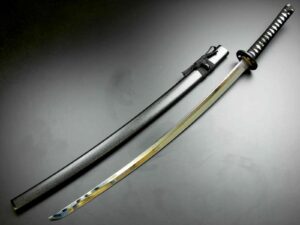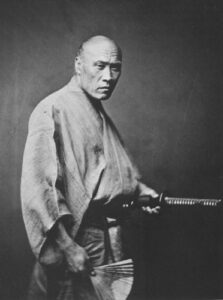In Japan, the history of the sword is deeply entwined with the history of the samurai. The samurai were the warrior-elite nobility of pre-industrial Japan. Deeply versed in the arts of war, by the end of the Sengoku period (1600 AD) their attention to warfare had elevated weapon mastery to a form of art.
Miyamoto Musashi was one such master. He won his first duel at the age of thirteen, and went on to be victorious in over sixty of those deadly contests. He developed the Niten-ryu (Two heavens school – utilising two swords) system of combat and wrote the Book of Five Rings, a philosophical expose of his thoughts on military tactics.
Sasaki Kojiro was another noble warrior of the time. Famous at a young age for his skill and feared for his hideous speed with the blade, he developed a technique known as the swallow cut. This technique involves a strike which simulated the motion of a swallow’s tail in flight. Reputedly, it was so precise that it was able to cut a bird in the air mid-flight. Kojiro met his end on the beach of Ganryujima in a duel against Musashi. The duel was so celebrated that it became an epic in the canon of the Japanese people.
Few men where as feared as Mataemon Araki, who slew fourteen people at Kagiya corner in one of the most famous acts of revenge. He was poisoned shortly after he had attained vengeance. His murderer was never found.
Much must also be said of the Yagyu clan who developed one of the most celebrated schools of swordsmanship, the Shinkage Yagyu Ryu. It was made famous in Japan by Sekishusai Yagyu, whose son Munenori went on to perfect its applications. But it was Munenori’s own son Mitsyori, also known as Jubei, who would make the style legendary.
Tradition holds that Jubei had only one eye, the result of a mutilation in a sparring match with his father. Some accounts hold it accidental; others say that his sire sought to teach him that even the affection binding father and son must be used to one’s advantage in a fight. Nevertheless, Jubei became a master swordsman. His mysterious lengthy disappearance is thought to be due to training with the Ninja of Iga province. He fought at the famous battle of Harano castle, the final conflict of the Shimabara rebellion. He may have been one of the saboteurs who flew over the castle walls on a large kite, in the world’s first instance of aerial warfare. The saboteurs proceeded to set fires behind enemy lines and opened the castle gates for the Shoguns forces.
He died many years later under uncertain circumstances.
The weapon of choice of all these men was the katana, without doubt the finest of all sword designs. The forging of a katana blade is complex process, involving specialised smelting techniques like folding of the steel thousands of times and gradual cooling period using clay. In medieval Japan, a finished blade was tested on the body of a dead criminal. It had to be able to cut cleanly through the torso with a single strike. Today, katana swords are made both in the traditional manner and with machines. The former can sell for as much as fifty thousand dollars, while the latter can go for as little as ten dollars.
You can find a range of different quality Katana swords on bidorbuy.











